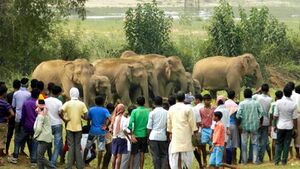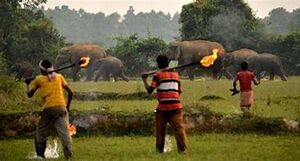Elephants in the tea garden: Conflict with Elephants in North India
Introduction
Elephants are considered one of the mammals roaming the earth and can be found in a variety of countries in Sub-Saharan Africa and Southeast Asia. With a high intellectual capacity, their vivid memory and emotional capacity set them apart from an average animal. This distance has allowed elephants to receive an abundance of love from billions across the world with their continued appearances on funny zoo videos and nature documentaries. However, what is not commonly known is that elephants are currently an endangered species, and have rapidly declined in sum over the past century. The area of Northern India is particularly rich with elephants, more specifically Asian elephants, and “has 60% of the global Asian elephant population while the rest are shared between Nepal, Myanmar, Thailand, Sri Lanka, Malaysia, and Indonesia” (Naha, 2020).
Northern India is a relatively broad area that encompasses around 75% India’s population and 73% of the country’s total land area. The region is rich in culture and diversity with its landscape just as varied hosting plains, mountains, and dense forest. It is no surprise that these biomes are extremely biodiverse and home to rare and endangered animal species such as snow leopards, tigers, and elephants. Historically, elephants specifically have played a large part in Northern India’s culture depicted throughout religious text, artwork, and have aided in the region's economy and warfare. Recently, elephant populations in the area have dwindled as habitat loss, human-elephant conflicts, and poaching aim to drive the animals out of the region. Although the country relies on the animals for tourism in regions such as Rajasthan and Uttar Pradesh, the complex relationship between humans and these animals is getting too much for many locals, and governments in the region, raising the possibility of a future where elephants do not roam the jungles of Northern India.
History
3300 BCE - 19th Century (A Time at Peace)
Elephants have roamed the plains of India’s northern region for centuries with one of the earliest human-elephant interactions in the area traced back to the Indus Valley civilization sometime between 3300-3000 BCE. Although there were most likely earlier interactions between elephants and humans in the area, this was the first one to be documented. During the Vedic period from 1500- 500 BCE elephants began to play a more prominent role in the region's society being referenced in the Rigveda, one of Hinduism's oldest and most sacred texts. In this text, elephants are portrayed as majestic creatures that were closely related with kings. The might and strength of an elephant is most likely what drew this conclusion. From then on, elephants were praised as symbols of strength and power and used in battles and religious ceremonies. The patronage of elephants was further exemplified under the reign of Emperor Chandragupta Maurya and The Maurya Empire from 322-185 BCE. The leader loved the animal and made various efforts to protect and conserve the beautiful species. This lead precedence for elephants to be revered and praised throughout the region of Northern India up until the end of the 19th century when “negative interactions between humans and elephants [began] arising from shared space and overlapping food resources” (Das et al., 2022, pg. 2).
19th Century - 2024 (A Time at War)
Violent conflicts have arisen between humans and elephants in Northern India. The region's high population and the vast spread of citizens over the country's landscape have allowed tensions to rise significantly and at an increasingly rapid pace. These conflicts are started over a number of things such as crop raiding, property damage, and elephant attacks on civilians, yet there are two sides to the story. Rapid urbanization through new development has seen ancestral elephant paths being blocked. Elephants in the area are also suffering from the effects of large scale habitation fragmentation and loss causing human-elephant interaction to become commonplace. The extent to which elephants damage property and raid crops is immense with “600,000 families and 1 million hectares of land affected” “annually” (Naha, 2020). This has led farmers in Northern India to retaliate against the animals causing further violence (An estimated 600 humans and 300 elephants die annually in India and Sri Lanka as a consequence of human-elephant ) (Naha, 2020).
As India past regarding the appreciation of elephants is in stark contrast with the present, further questions arise regarding the viability of elephants roaming Northern India far in the future. Along with many other great animals, elephants are an endangered species and are greatly threatened by habitat loss, poaching, and general conflicts with humans. Although the animal was once loved and is still loved in the region by many, some government measure has to be put into place to disrupt this cycle of violence against elephants who just want to follow their ancestral paths and live in the habitats that they once did.
Current Remedial Action
Currently there are efforts are being made to reduce conflict between humans and elephants in Northern India. Although the conversation has begun on how to tackle the issue, no real commitment has been made by the government, and instead, individuals who are being affected the most severely are the ones coming up with answers on how to reduce human-elephant interaction. Because it is mainly farmers in rural Northern India that have families to feed coming up with solutions, the good of the elephants are not usually taken into account unless they also completely benefit the ones attempting to solve the problem. This issue further exemplifies the need for government interaction as there is no one attempting to protect the elephants or acting as a mediator between both sides. That being said, those wanting to protect the endangered Asian elephant in Northern India have devised their own, friendlier solutions the problem.
Improved Land Planning
Land planning has been a critical implementation for farmers in Northern India to reduce there confrontations with elephants. Land planning can be done in a number of ways and encompasses a variety of ideas such as a solar-powered electric fence. It is a sustainable security solution, as sunlight is converted into electricity to power the electric fence. They are proven to be affective compared to other methods as “It means that a solar fence may be relatively more effective than a trench in reducing elephant incursion into the human-settlement areas relative to the non-barrier sites, since fewer elephant signs were encountered.” (Das, 2022)
Creation of Buffer Zones
Zones are set up on the edges of human settlements or agriculture that create an area that provides a clear boarder between the elephant's habitat and human settlement. This can reduce the chances of human-elephant interaction and stop things like crop raiding.
Early Warning
Implementing systems such GPS collars on elephants can help notify communities when an elephant is present in their area. This would allow the community to prepare for conflict or be better suiting to avoid conflict.
Deterrence Measures
Non-lethal deterrents such as sound cannons or other trained elephants can be used to deter elephants. Physical structures such as solar fences are gaining popularity as they "may be relatively more effective than a trench in reducing elephant incursion into the human-settlement areas relative to the non-barrier sites, since fewer elephant signs were encountered” (Das, 2022).
Identification of Ancestorial Elephant Paths
The identification of ancestorial elephant paths and the communication of the knowledge has allowed communities to shift out of harms way or in some cases rethink future development of the community.
Solution
Protected Areas
Protected areas can be a great addition for the sake of conservation. They can promote biodiversity and create socioeconomic harmony within their space. As mentioned, elephants can cause economic harm to urban areas’ agriculture due to crop raiding. With protected areas, these species can roam in the protected areas without the concern of damaging crops. In a social aspect, this reduces the number of human-elephant conflicts. These spaces could potentially be used for tourism or visitors, which would benefit the economy. Culturally, elephants play a significant role within India, especially Hinduism. With their historic value from mythological wisdom and strength to the symbolism of royalty and power, these animals are substantially important to the culture of India.
The Path Forward
The current state of North India is quite developed in contrast to the south. With new changes in these areas, the population of civilians quickly rises. While curating these developments within political and legal viewpoints, elephants should also play a role in these decisions. For example, elephants are known to follow ancestral migration routes. If these routes were sectioned off specifically for elephant use, the rate of human-elephant conflicts involving casualties would decrease. This comes into perspective when improving land use. In relation, crops and agricultural sites should be aware of these routes to avoid crop raids and land damage. The most impacted group is the farmers in the agriculture industry. To avoid the resentment that these farmers face, the implementation of a compensation system could be a positive solution. In Africa, a current method is estimating the visual damage, which is then approved by an agency. This method does come with uncertainty, such as under or over compensation. A suggestion for this problem would be calculating the net sum of produce loss. (Millind, 2015).
Conclusion
Elephants in Northern India are under a barrage of threats stemming from and our intuition to retaliate. Urbanization and development has pushed humans to the edge of nature and into the natural habitats of elephants who do not know what is happening, yet feel under attack. Because of this close proximity to nature that those living in Northern India have found themselves, human-elephant interaction has taken many lives and continues to be a burden that many farmers feel is solely the animals fault. Current remedial action on the issue such as land planning techniques are effective on a case-by-case basis, yet do not pose a single answer that can be applied everywhere.
Elephants in North India, even around the globe, deserve the right to fulfil their lives as mammals on earth. Using an biocentric perspective, each living organism on the deserves and holds on to their right to live and roam their tradition territory. With that said, the best way to approach the issue in Northern India is through the government implementation of protected areas. As government interaction into this issue has been limited, a strong presence such as the government enforcing rules inside these protected areas would allow the Asian Elephants to have their own space away from civilizations where they can be safe from the threats of humans. This also allows villages to not have to invest into costly deterrence or early warning systems and instead focus that saved money on further agricultural advances. Although this may not out weigh the damage done by previous crop raiding, it provides a situation where those most affected can recover from the financial burden and relocate money into what will in-turn make them more money. This outcome would also reduce unnecessary casualties and set precedent for the protection of other endangered species in the region.

